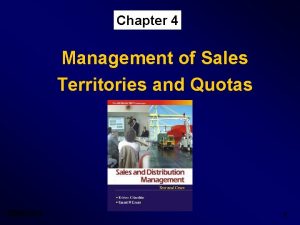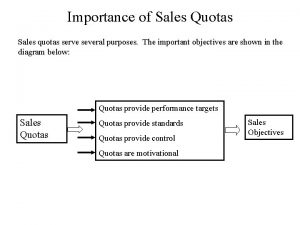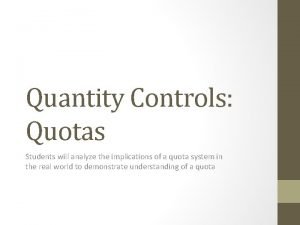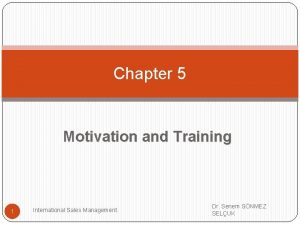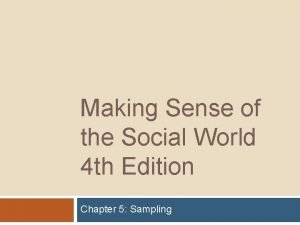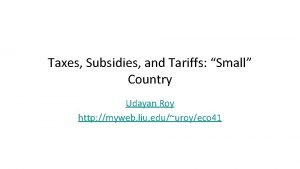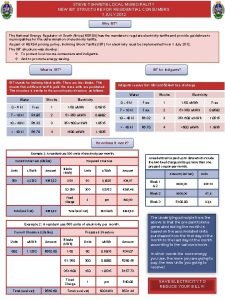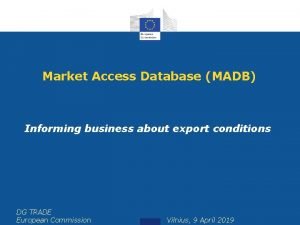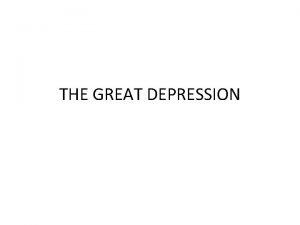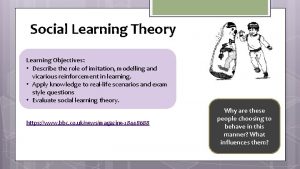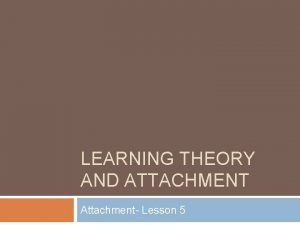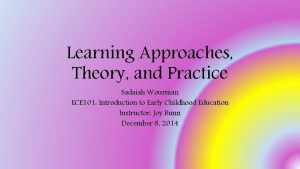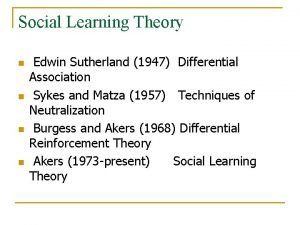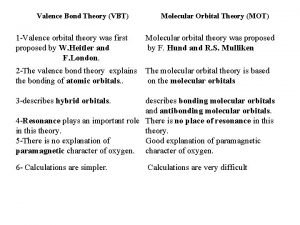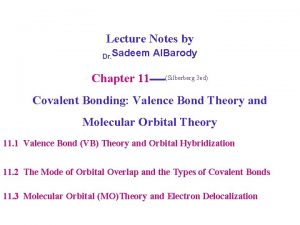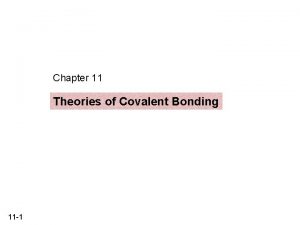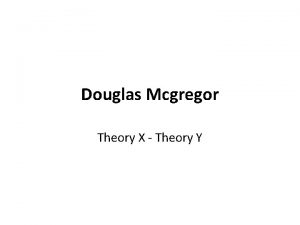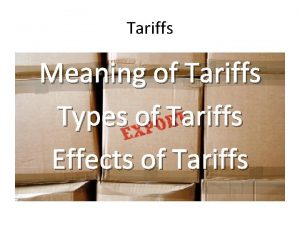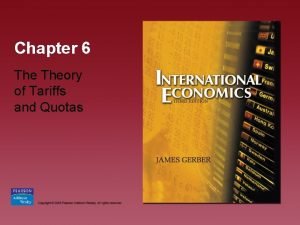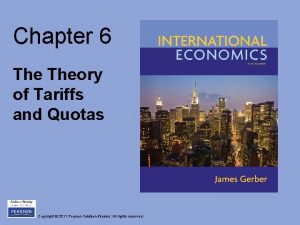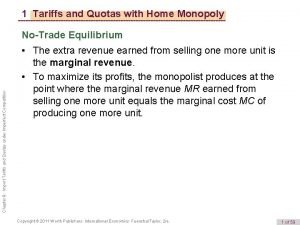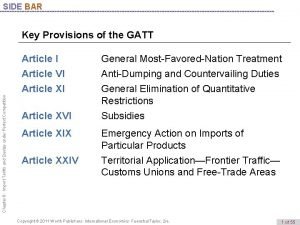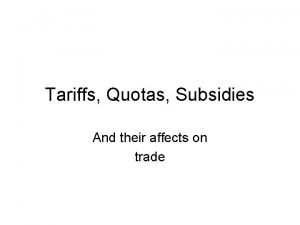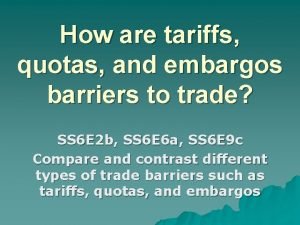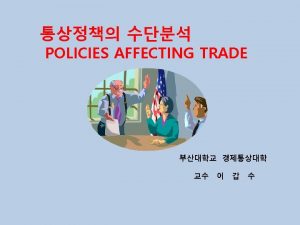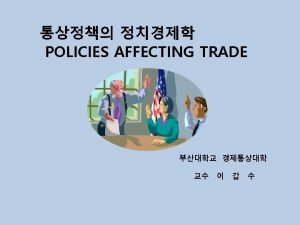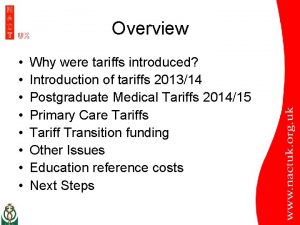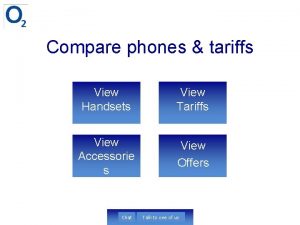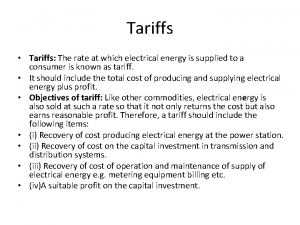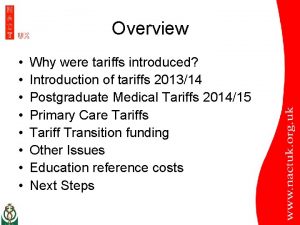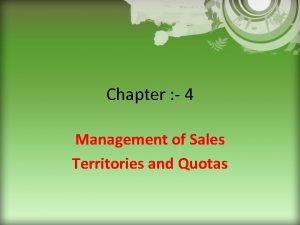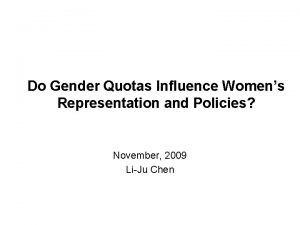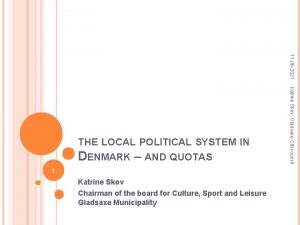Chapter 6 Theory of Tariffs and Quotas Learning










































- Slides: 42

Chapter 6 Theory of Tariffs and Quotas

Learning Objectives • Draw a supply and demand diagram and use it to illustrate consumer and producer surplus. • Draw a graph that shows the effects of tariffs and quotas on prices, output, and consumption. • Explain in words and with a diagram the effects of tariffs and quotas on resource allocation and income distribution. Copyright © 2014 Pearson Education, Inc. All rights reserved. 6 -2

Learning Objectives (cont. ) • Differentiate effective from nominal rates of protection. • List and discuss at least three dynamic costs of protection. Copyright © 2014 Pearson Education, Inc. All rights reserved. 6 -3

Introduction: Tariffs and Quotas • This chapter and the next chapter provide an introduction to theory and policy of tariffs and quotas • This analysis is called commercial policy • The inefficiency and expense of tariffs and quotas to protect industries and jobs are apparent once direct costs are measured Copyright © 2014 Pearson Education, Inc. All rights reserved. 6 -4

Analysis of a Tariff • There are numerous barriers to trade, some are obvious (transparent), others are not (non-transparent) – Quotas: direct limit on imports: regulate the quantity of imports – Tariffs: indirect limit on imports: impose a tax on imports Copyright © 2014 Pearson Education, Inc. All rights reserved. 6 -5

Analysis of a Tariff (cont. ) • Tariffs and quotas encourage – Consumers to switch to relatively cheaper domestic goods or to drop out of the market – Domestic producers to increase their output as demand switches from foreign to domestic goods • This chapter is a partial equilibrium analysis of the effects of tariffs and quotas: Considers only their impact on the industry on which they are imposed, rather than their economy-wide effects Copyright © 2014 Pearson Education, Inc. All rights reserved. 6 -6

Consumer and Producer Surplus There are two key concepts in the analysis of the impact of tariffs – Consumer surplus: value received by consumers in excess of the price they pay (can be measured only if the demand curve is known) – Producer surplus: value received by producers in excess of the minimum price at which they are willing to produce (can be measured only if the supply curve is known) Copyright © 2014 Pearson Education, Inc. All rights reserved. 6 -7

FIGURE 6. 1 Consumer and Producer Surplus Copyright © 2014 Pearson Education, Inc. All rights reserved. 6 -8

Prices, Output, and Consumption Assume: 1. There is only one price for a good (world price Pw ) 2. Foreign producers are willing to supply us with all of the units of the good we want at that price Copyright © 2014 Pearson Education, Inc. All rights reserved. 6 -9

FIGURE 6. 2 Domestic Supply and Demand for an Imported Good Copyright © 2014 Pearson Education, Inc. All rights reserved. 6 -10

Prices, Output, and Consumption (cont. ) • Now assume: Government imposes a tariff of amount “t. ” Importers will still be able to buy the good from foreign producers for Pw, but they will have to pay the import tax of “t. ” – The tax is subsequently tacked onto the price to domestic consumers: price to them is Pw+ t=Pt – The consumption of the imported good subsequently decreases Copyright © 2014 Pearson Education, Inc. All rights reserved. 6 -11

FIGURE 6. 3 The Effects of a Tariff Copyright © 2014 Pearson Education, Inc. All rights reserved. 6 -12

Prices, Output, and Consumption (cont. ) • In Summary, – tariffs cause the domestic price to rise by the amount of the tariff, – domestic consumption falls, – domestic production rises, – imports fall. Copyright © 2014 Pearson Education, Inc. All rights reserved. 6 -13

Resource Allocation and Income Distribution • Tariffs have more subtle effects than just a rise in prices and a fall in imports. - Inputs in domestic production: increase domestic production requiring additional resources of land, labor, and capital to be reallocated from their prior uses into the industry receiving protection under the tariff. - when the price changes, consumer and producer surplus do too Copyright © 2014 Pearson Education, Inc. All rights reserved. 6 -14

Resource Allocation and Income Distribution (cont. ) • Deadweight loss- destruction of value that is not compensated by a gain somewhere else : area d is this type of loss. • Efficiency loss- another deadweight loss which occurs on the production side: area b is this type of loss Summary- the net effect of the tariff on national welfare = gains to producers + gains to government - losses to consumers = (a + b + c + d - a - c) = b + d: Copyright © 2014 Pearson Education, Inc. All rights reserved. 6 -15

TABLE 6. 1 Economic Effects of the Tariff in Figure 6. 3 Copyright © 2014 Pearson Education, Inc. All rights reserved. 6 -16

A Comparison of Tariff Rates • The Doha Development Agenda of the World Trade Organization (WTO) is focused on the trade problems of developing countries • At issue for many developing countries are the levels of tariffs and other industrial country barriers that block access to agriculture, clothing, and textile markets. • However, developed nations often have highest tariffs in agriculture, textiles, and other laborintensive products – the very products developing nations would like to export Copyright © 2014 Pearson Education, Inc. All rights reserved. 6 -17

Comparison of Tariff Rates (cont. ) • Industrial countries, the World Bank, and the WTO have argued major problem facing developing countries is the relatively high level of protection among themselves • High tariffs limit the countries’ ability to sell into each other’s markets—and consequently their ability to follow their comparative advantage. Copyright © 2014 Pearson Education, Inc. All rights reserved. 6 -18

FIGURE 6. 4 Average Tariff Rates, 1986 -2010 Copyright © 2014 Pearson Education, Inc. All rights reserved. 6 -19

Other Potential Costs • A tariff may have effects that are less predictable and harder to quantify – Retaliation by other countries: adds to the net loss of a tariff by hurting export markets of other industries; can escalate rapidly – Innovation: tariffs reduce competitive pressures on domestic firms and thus their incentives to innovate and improve the quality of existing products Copyright © 2014 Pearson Education, Inc. All rights reserved. 6 -20

Other Potential Costs of a Tariff (cont. ) – Rent seeking: any activity that uses resources in order to capture more income without actually producing a good (e. g. , firms hire lobbyists to maintain tariff protection) - Political systems that do not easily provide tariffs are more likely to avoid rent seeking Copyright © 2014 Pearson Education, Inc. All rights reserved. 6 -21

The Large Country Case • Economists distinguish between small and large countries in analyzing tariffs – Large country: one that imports enough of a particular product so that if it imposes a tariff, the exporting country will reduce its price of the good in order to keep its share of the large country's market • In theory, large countries can improve their national welfare by imposing a tariff as long as their trading partners do not retaliate Copyright © 2014 Pearson Education, Inc. All rights reserved. 6 -22

FIGURE 6. 5 Tariffs in the Large Country Case Copyright © 2014 Pearson Education, Inc. All rights reserved. 6 -23

Effective versus Nominal Rates of Protection • The amount of protection given to any one product depends not only on the tariff rate but also on tariffs on the inputs used to produce the good – Nominal rate of protection: tariff rate levied on a given product – Effective rate of protection: nominal rate + tariffs on intermediate inputs – Value added: price of a good minus the costs of intermediate goods used to produce it (the contributions of labor and capital at a given stage of production) Copyright © 2014 Pearson Education, Inc. All rights reserved. 6 -24

Effective versus Nominal Rates of Protection (cont. ) • In sum, effective rate of protection = (VA* - VA) / VA - VA = amount of domestic value added under free trade; VA* = domestic value added after taking into account all tariffs (on both final goods and intermediate inputs) Copyright © 2014 Pearson Education, Inc. All rights reserved. 6 -25

TABLE 6. 2 Nominal and Effective Rates of Protection Copyright © 2014 Pearson Education, Inc. All rights reserved. 6 -26

Table 6. 3 The Uruguay Round Copyright © 2014 Pearson Education, Inc. All rights reserved. 6 -27

Analysis of Quotas • Quota: A quantitative restriction that specifies a limit on the quantity of imports • Differences between quotas and tariffs – Tariff limits imports by imposing a tax on them – Unlike tariffs, quotas do not generate tariff revenue for the government • Similarities between quotas and tariffs – Both lead to a reduction in imports, a fall in total domestic consumption, and an increase in domestic production Copyright © 2014 Pearson Education, Inc. All rights reserved. 6 -28

Types of Quotas 1) Most transparent type of quota: – an outright limitation on the quantity of imports e. g. , a limit on the quantity of imports from country x, or a limit on the quantity of imports from the rest of the world as a whole Copyright © 2014 Pearson Education, Inc. All rights reserved. 6 -29

Types of Quotas (cont. ) 2) Import licensing requirement: – forcing importers to obtain government licenses for their imports; – government regulates the number of licenses available Copyright © 2014 Pearson Education, Inc. All rights reserved. 6 -30

Types of Quotas (cont. ) 3) Voluntary export restraint (VER) (or voluntary restraint agreement, VRA) – the exporting country “voluntarily” agrees to limit its exports for a period Copyright © 2014 Pearson Education, Inc. All rights reserved. 6 -31

Types of Quotas: VERs • VERs have similar effects as quotas – However, VERs are more popular, as they (1) do not require domestic legislative action; and (2) allow politicians to provide protection for domestic industry and to appear as proponents of free trade • The use of VERs increased with the decline in tariffs that results from the global trade rounds; however, recent international negotiations have restricted the use of VERs Copyright © 2014 Pearson Education, Inc. All rights reserved. 6 -32

The Effect on the Profits of Foreign Producers • The main difference between tariffs and quotas is that there is no government revenue from quotas. • In place of tariff revenue, there are greater profits foreign producers, called quota rents. Copyright © 2014 Pearson Education, Inc. All rights reserved. 6 -33

The Effect on the Profits of Foreign Producers (cont. ) • Two circumstances that can limit quota rents – If there is a large number of foreign producers, competition may limit their ability to increase prices – The government can extract the extra profits from foreign producers through an auction for import licences Copyright © 2014 Pearson Education, Inc. All rights reserved. 6 -34

FIGURE 6. 6 Analysis of a Quota: 1 • Quota rents: Increased profits accruing to foreign producers from the use of quotas; take the place of tariff revenue Copyright © 2014 Pearson Education, Inc. All rights reserved. 6 -35

The Effect on the Profits of Foreign Producers (cont. ) • Second important difference between tariffs and quotas: • Over time, as demand for the good increases and quota remains fixed: increase in consumer demand, increases the price paid by consumers, increases in producer surplus garnered by domestic firms. • In contrast, an increase in consumer demand for an item that has an import tariff increases the quantity of imports and leaves the price intact Copyright © 2014 Pearson Education, Inc. All rights reserved. 6 -36

FIGURE 6. 7 Analysis of a Quota: 2 • In the case of a tariff, the government earned revenue from imports; in the case of a quota, foreign producers receive extra profits (c) Copyright © 2014 Pearson Education, Inc. All rights reserved. 6 -37

Hidden Forms of Protection • Any trade barrier that reduces imports without imposing a tax has effects similar to those of a quota – Tariffs: impose a tax – Non-tariff barriers (NTBs): quotas and non-tariff measures Copyright © 2014 Pearson Education, Inc. All rights reserved. 6 -38

Hidden Forms of Protection (cont. ) • Non-tariff measures are hidden, nontransparent forms of protection, such as: - excessively complicated customs procedures, - environmental and consumer health and safety precautions, - technical standards, - government procurement rules, - limits imposed by state trading companies Copyright © 2014 Pearson Education, Inc. All rights reserved. 6 -39

Intellectual Property Rights and Trade • Intellectual property (intellectual property rights) are usually divided into: – Copyrights and related rights for literary and artistic work, – Industrial property rights for trademarks, – Patents, – Industrial designs, – Geographical indications – Layout of integrated circuits Copyright © 2014 Pearson Education, Inc. All rights reserved. 6 -40

Intellectual Property Rights and Trade (cont. ) • There are rules for respecting intellectual property rights as they relate to trade • These rules were negotiated during the Uruguay Round (1986 -1994) with the Trade Related Aspects Intellectual Property Rights (TRIPS) agreement Copyright © 2014 Pearson Education, Inc. All rights reserved. 6 -41

Quiz • Given that tariffs and quotas cost consumers and that they are grossly inefficient means for creating or preserving jobs, why do citizens allow these policies to exist? Copyright © 2014 Pearson Education, Inc. All rights reserved. 6 -42
 Establishing sales territories
Establishing sales territories Types of sales quotas
Types of sales quotas Expense quota
Expense quota Taxi quotas
Taxi quotas Churchill ford and walker model
Churchill ford and walker model Quota sampling
Quota sampling Cuadro comparativo entre e-learning b-learning y m-learning
Cuadro comparativo entre e-learning b-learning y m-learning Government tariffs
Government tariffs How to calculate electricity tariffs grade 11
How to calculate electricity tariffs grade 11 Tariff structure statement
Tariff structure statement Amanzi ka gezi
Amanzi ka gezi Madb database
Madb database Tariffs deadweight loss
Tariffs deadweight loss High tariffs great depression
High tariffs great depression Inductive and analytical learning
Inductive and analytical learning Focl in machine learning
Focl in machine learning Eager and lazy learning
Eager and lazy learning Tony wagner's seven survival skills
Tony wagner's seven survival skills Social and learning theory
Social and learning theory Learning theory of attachment
Learning theory of attachment Learning approaches, theory, and practice
Learning approaches, theory, and practice Social learning theory and cybercrime
Social learning theory and cybercrime Sutherland social learning theory
Sutherland social learning theory A remarkable turnaround case study
A remarkable turnaround case study Continental drift vs plate tectonics
Continental drift vs plate tectonics Continental drift vs plate tectonics
Continental drift vs plate tectonics Neo classical organizational theory
Neo classical organizational theory Motivation in group formation
Motivation in group formation Hawthorne theory of motivation
Hawthorne theory of motivation Plate theory chromatography
Plate theory chromatography Lien theory vs title theory
Lien theory vs title theory Y management
Y management Game theory and graph theory
Game theory and graph theory Difference between mot and vbt with example
Difference between mot and vbt with example Molecular orbital theory and valence bond theory
Molecular orbital theory and valence bond theory Theory x and theory y
Theory x and theory y Valence bond theory and molecular orbital theory
Valence bond theory and molecular orbital theory Theories of covalent bonding
Theories of covalent bonding Valence bond theory example problems
Valence bond theory example problems General douglas mcgregor
General douglas mcgregor Supervised learning dan unsupervised learning
Supervised learning dan unsupervised learning Concept learning task in machine learning
Concept learning task in machine learning Analytical learning in machine learning
Analytical learning in machine learning
